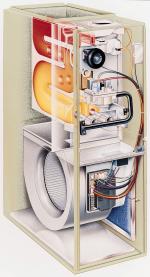Search engine visitors - click here to access entire "$ensible Home" web site
Click here to see a descriptive illustration showing the internal parts of a gas furnace.
Dear Jim: My furnace is old, but it still seems to heat well. My budget is tight, so I need to keep my utility bills low and the furnace working for a long time. Are there any simple tune-up checks I can make myself? - Ken E.

A: Doing your own annual gas furnace tune-up will not eliminate the need for an inspection by a qualified technician every several years, but it can cut your utility bills by as much as $100. Also, a well-maintained furnace will have a longer than average life-span.
Since a central air conditioner uses the same air handler (blower), ductwork, thermostat, etc., your annual furnace tune-up will also save money during the summer. If your air conditioner did not keep your house adequately cool on the hottest days, this tune-up will help.
Inspect the furnace opening for black soot, a sign of poor combustion or backdrop. Turn up the thermostat to start the furnace and try to view the flames. They should be steady and blue, not yellow and dancing. If they don't look right or you find soot, call a service technician for help.
You would normally smell any gas leaks, but it does not hurt to still check for them. Mix a strong solution of dishwasher liquid and water and put a few drops on each gas line fittings. Bubbles quickly form if there are any leaks.
For your tune-up, switch off the electric power to the furnace first. The main circuit breaker box is the best place. The transformer that operates the controls makes a humming sound. If it is still humming, you have not found the correct breaker.
Remove the side cover to gain access to the blower compartment. Using the brush attachment for your vacuum cleaner, clean off as much dust as possible. The furnace filter should be changed every several months, so this is probably a good time to install a new one.
If there are areas you cannot reach with the brush, wipe them off with a damp rag. Try to wipe off as much of the squirrel-cage blower wheel as possible. A layer of dirt on the wheel can reduce its air flow capacity.
While you are working around the blower wheel and the motor, look for tiny oil cups near the ends of the motor shaft. Not all models will have them. If you see them, put a couple of drops of bearing oil in each of the cups.
Most blowers are direct-drive, but some have pulleys and a belt. For a belt-drive blower, the belt should flex up and down about one-half inch in the center. To adjust the belt, loosen the motor mounting screws and slide the motor as needed.
When you replace the side cover, tighten the screws to make it as airtight as possible. Also check all the other screws you can find for tightness.
Instant Download Update Bulletin No. 804 - do-it-yourself gas furnace tune-up guide, 55-point gas furnace troubleshooting guide showing symptom with possible causes and how to check or repair, energy saving tips, a furnace sizing chart, illustrations and explanation on how a gas furnace works and definitions of various heating terms.
Dear Jim: I like to use natural ventilation when possible. I have heard I should open the windows on the second floor just a little and the ones on the first floor more. Is this correct and why? - Sandi D.
A: What you have heard is just backwards in theory. Since hot air rises, you should open the second-floor windows further (exhaust). This is supposed to draw air in the first floor windows at a higher velocity.
The theory sounds great, but in general, just open all your windows as much as possible. In most areas, there is usually some natural air movement outdoors that will more than offset the theoretical effect I described.